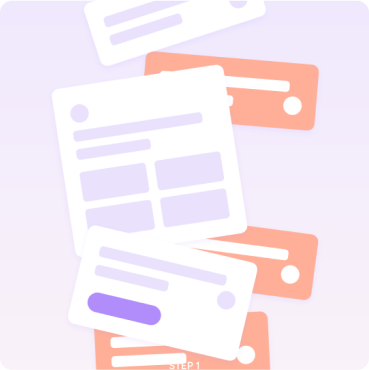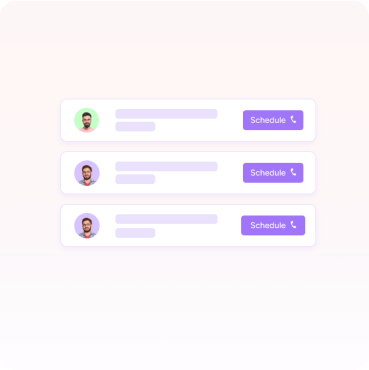Regular hiring
High RiskHire Frontend developers of Silicon Valley caliber
Hire pre-vetted full time remote Frontend developers from India. Hire now and build your dream engineering team with Hyno
Join 4,000+ companies already growing








Our Top Remote Developers
Hyno conducts rigorous testing and carefully vets the developers who are fueled by passion and skill sets. Hence, our developer community is the foundation for innovation and collaboration, bringing ideas and projects to fruition.
OUR STANDARDS
Hyno vs. Your regular recruitment process.
Find a risk-free, pre-interviewed, high-quality developer who is remote-ready in less than 2 weeks at 40% less cost.
Parameters
Choose the right for your firm.Time
Fees
Quality
Pre Screening
Remote readiness check
Termination
Failure rate
1 - 4 Months
> $1000
High
Low
Freelancing
High Risk1 - 2 Months
No fee
No
Very high
 Low Risk
Low Risk
0 - 15 Days
No fee
No
Very low
Pricing Starts from $35/hr
Accomplishing everything in just 3 steps
Our technical manager aligns the required skillset and tech stack with our talent pool to help you find the best fit.

Shortlisting candidates
Precise Hiring: Understanding, Gathering, and Shortlisting nittygritty.
-
 We start by thoroughly understanding your unique needs and specifications.
We start by thoroughly understanding your unique needs and specifications.
-
 check markWe
align the developer details with company goals. This way, we tailor the candidate
selection to seamlessly integrate with the organization’s vision and goals.
check markWe
align the developer details with company goals. This way, we tailor the candidate
selection to seamlessly integrate with the organization’s vision and goals.


Scheduling an Interview
Effortless talent selection: Finding your perfect match
-
 We connect you with the chosen candidates to ensure a personalized experience.
We connect you with the chosen candidates to ensure a personalized experience.
-
 Our rigorous
selection process guarantees that you find candidates who align seamlessly with your
requirements.
Our rigorous
selection process guarantees that you find candidates who align seamlessly with your
requirements.


Onboarding the talent
Streamlined onboarding for peak performance.
-
 The selected/qualified talent integrates smoothly through structured onboarding to
quickly adapt to projects, processes, and team dynamics.
The selected/qualified talent integrates smoothly through structured onboarding to
quickly adapt to projects, processes, and team dynamics.
-
 We go beyond
integration to offer ongoing support for a seamless transition to ensure that the
new talent exceeds your expectations.
We go beyond
integration to offer ongoing support for a seamless transition to ensure that the
new talent exceeds your expectations.


Read hiring guide
A one-stop shop to hiring the right Frontend Developer
How to hire a Frontend developers? Skills to look for, interview questions, and more
Hiring a dedicated developer for your business can
be a cumbersome task. As many companies are competing to hire top Frontend
developers,
so finding a good developer is not as easy as it may seem.
We're here to assist all employers who choose to hire Frontend developers on their
own. Recruiting a developer on your own requires a fair amount of software
development experience in general. However, if you're a non-technical manager
interested in learning more about how to hire a Frontend developers, we've put up
an excellent resource for you.
Things to check Key Skills Required for a Frontend Developer?
The following are the key skills that a developer should possess to become proficient in Frontend:
1. Proficiency in HTML, CSS, and JavaScript: A dedicated front-end developer should understand the foundational technologies of the web - HTML for structure, CSS for styling, and JavaScript for interactivity.
2. Experience with frontend frameworks and libraries: Frontend developers should be familiar with popular frontend frameworks like React, Angular, and Vue.js, and libraries like jQuery, Bootstrap, and Material UI.
3. Understanding of responsive design: A frontend developer should be able to build websites and applications that look and function well across different devices and screen sizes.
4. Knowledge of web performance optimization: A good frontend developer should know how to optimize website and application performance. This includes image and media optimization, minimizing HTTP requests, and using caching and compression.
5. Familiarity with version control systems: A front-end developer should be comfortable using version control systems like Git to manage code changes and collaborate with other developers.
6. Understanding of web accessibility: A front-end developer should be aware of web accessibility standards to create solutions that offer accessibility to people with disabilities.
7. Knowledge of testing and debugging: A front-end developer should be skilled in testing and debugging code.
8. Ability to work with APIs: A front-end developer should be able to work with APIs to retrieve and display data from external sources.
9. Familiarity with CSS preprocessors: A front-end developer should be comfortable using CSS preprocessors like Sass or Less to streamline the process of writing CSS.
10. Knowledge of building tools and task runners: A frontend developer should be familiar with tools like Webpack, Gulp, or Grunt to automate the development and deployment of websites and applications.
Ideal Hiring Process for Frontend Developer
1. Define the job description: Clearly define the job responsibilities, qualifications, and skills required for the position. This helps you attract the right candidates for the job.
2. Post the job opening: Post the job opening on online job boards, social media, and other relevant platforms. Make sure to highlight that the position is remote.
3. Review resumes and applications: Review the resumes and applications you receive to determine the right fit of the job.
4. Conduct initial interviews: Conduct interviews with candidates via phone or video call to get a sense of their experience, skills, and personality.
5. Assign a test project: Evaluate their technical skills and problem-solving abilities with a test assignment using a project that is relevant to the job responsibilities.
6. Conduct a second round of interviews: Conduct a second round of interviews with the candidates who perform well on the test project. This is an opportunity to ask more detailed questions and evaluate the candidate's fit for the job and the company culture.
7. Check references: Examine candidates' references to confirm their experience and skill set.
8. Make an offer: Extend an offer to the candidate that best fits the job. Negotiate the terms of employment, including compensation, work schedule, and benefits.
9. Onboard the new hire: Once the candidate accepts the offer, onboard them to ensure they have the necessary equipment, software, and training to start the job.
10. Provide ongoing support and feedback: Provide ongoing support and feedback to the new hire to ensure they can work effectively and meet the job expectations. Regular check-ins, team meetings, and feedback sessions help ensure the new hire succeeds.
Important Interview questions to ask to Hire a Frontend Developer
What are the differences between HTML, CSS, and JavaScript?
HTML is used for creating the structure of web pages, CSS is used for styling and layout, and JavaScript is used for adding interactivity and functionality to web pages.
How do you ensure that your website is responsive and works well on different devices?
Using responsive design techniques like media queries, fluid layouts, and flexible images ensures that the website looks good and works well on different devices.
What are some of the popular frontend frameworks and libraries that you have worked with?
I have worked with React, Angular, and Vue.js, as well as libraries like jQuery, Bootstrap, and Material UI.
How do you optimize website performance?
You can optimize the website performance by minimizing HTTP requests, compressing and caching files, optimizing images and other media. You should also minimize the use of plugins and scripts.
What are some common accessibility issues that websites can face, and how do you ensure that your website is accessible to everyone?
Common accessibility issues include using images without alt text, using color as the only way to convey information, and using small font sizes. To ensure the website accessibility, add alt text to images, using descriptive text and labels, and using semantic HTML.
How do you manage version control when working on a project with other developers?
Use Git for version control and GitHub or Bitbucket to collaborate with other developers. Follow a branching and merging strategy and use pull requests to review and merge changes.
Can you describe how you would implement a feature that requires data to be retrieved from an external API?
Use JavaScript to make a request to the API, retrieve the data, and parse it. Then, use the parsed data to display the information on the website.
What tools and software do you use to streamline your frontend development process?
Use build tools like Webpack, Gulp, or Grunt to automate the process of building and deploying websites and applications. Additionally, use CSS preprocessors like Sass or Less to streamline the process of writing CSS.
How do you approach testing and debugging frontend code?
Use tools like Jest, Mocha, or Jasmine for testing and debugging code. Also, use the browser developer tools to debug code in real-time.
Can you describe a challenging frontend project that you worked on and how you overcame any obstacles?
In the last project, we had to optimize the performance of a large e-commerce website. We had to reduce the page load times and improve the website's overall performance. Our team overcame these obstacles by using optimization techniques like lazy loading, image compression, and minifying the code. We also utilized Google PageSpeed Insights to analyze the website's performance and identify areas for improvement.
Job Description Template for Frontend Developer
Location: [Insert Location]
Job Title: Remote Frontend Developer
Position Type: Full-Time
Salary: [Insert Salary Range]
We are looking for an experienced Frontend Developer to join our team. You will be responsible for creating engaging and responsive user interfaces for web applications and websites.
Key Responsibilities:
- Develop and maintain user-friendly and responsive web pages and web applications using HTML, CSS, and JavaScript.
- Collaborate with the backend development team for frontend-backend integration.
- Ensure cross-browser compatibility and mobile responsiveness of web pages and applications.
- Use techniques like caching, minification and bundling to optimize the performance of web pages and applications.
- Collaborate with designers, product managers, and other stakeholders to develop wireframes and design mockups
- Ensure that the website and applications meet accessibility standards. Optimize them for search engines
- Continuously update skills and knowledge of emerging web technologies and trends
Requirements:
- Bachelor's degree in Computer Science, Engineering or a related field.
- 3+ years of experience in frontend web development.
- Strong proficiency in HTML, CSS, and JavaScript.
- Experience with modern frontend frameworks like React, Angular, or Vue.js.
- Experience with version control systems like Git.
- Knowledge of responsive design and mobile-first development practices.
- Ability to write clean, efficient, and maintainable code.
- Excellent problem-solving and debugging skills.
- Strong communication and collaboration skills.
If you are an experienced Frontend Developer who enjoys working in a fast-paced, challenging environment, we would love to hear from you. Please submit your resume and cover letter for consideration.